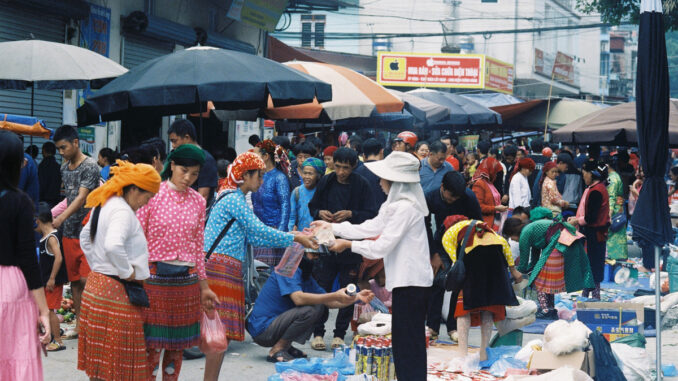
HA GIANG – Opens a market every Sunday, the largest market in Ha Giang is in Meo Vac district in the happiest winter of the year, attracting a large number of traders and tourists to visit and enjoy the cuisine.

In the last days of the year in Ha Giang, the rocky plateau is covered in rain, dust and fog. But on weekends, the atmosphere changes when crowded and bustling markets open.
Meo Vac market takes place every Sunday in the center of Meo Vac town, starting from about 4:00 a.m. to 4:00 p.m. From early morning, people from 18 communes and towns of Meo Vac district and neighboring communes of Yen Minh and Dong Van districts began to come to the largest market in the region to trade and sell. Market goers include men, women, children and the elderly.

Meo Vac market is the largest market in Ha Giang province, planned into each area according to the products for sale, from daily items to agricultural products.
Working in the field of documentary survey and cultural history, Mr. Nguyen Chi Nam, 38 years old (Hanoi), has been to the Meo Vac market many times, at different times of the year. He said the market is most crowded before and after the Lunar New Year. Before Tet is the time when people go shopping for supplies and food to prepare for the new year. After Tet, people come to participate in games and festivals.

The market gate is where the busiest trading activities take place. Here, there are areas for buying and selling livestock and poultry, as well as agricultural tools, food and snacks such as donuts and cornflakes. Electronic booths also gradually appeared according to the needs of local people.
Most of the agricultural products and necessities at the market are grown and made by people themselves, such as vegetables, agricultural tools, brocade fabrics, spices, and herbs.

Another outdoor area where people sell corn wine, is Ha Giang’s specialty wine. Women wear traditional costumes, and sit in rows, holding cans measuring wine in liters to sell to customers. Diners can taste wines before purchasing.
Corn wine is indispensable in feasts, offerings, parties, and meetings of local people. Next to the sale, there is an area for market-goers to sit and enjoy corn wine and chat and socialize.

Located in the center of Meo Vac market is a two-storey food court, which attracts the most people. The first floor focuses mainly on food stalls, with clear area division boards.

The food area is where people and tourists enjoy Ha Giang’s specialties such as thang co (photo), Trang Kim pho, buckwheat cake, men men, and au tau porridge.

Mr. Nam often eats pho and thang co when he goes to Meo Vac market. “In order to serve more tourists, Thang Co has now changed, the way of preparation is more hygienic. The pho is hand-coated by hand, directly, and eaten very fresh and delicious,” he said.

The second floor of the house is the slaughterhouse and fresh meat sales area. Meo Vac market is also a source of buffalo and beef meat for traders in the region.

Attracting many women are the clothing stalls on the second floor. The costumes come in a variety of colors and designs, embroidered with traditional motifs of the Mong, Dao, and Lo Lo ethnic groups. In addition, there is also a stall selling jewelry and accessories.

Attending many highland markets, from Dong Van, and Meo Vac to Quyet Tien, Ma Le, and Lung Phin markets, Mr. Nam found that the markets are basically quite similar, just different in scale.
After the Dong Van old market located at the foot of Don Cao mountain, next to the old town, was cleared in 2012, Meo Vac market is now the largest market, imbued with the cultural identities of Ha Giang’s ethnic groups. “Most people who come to the market wear traditional costumes of their people, and the items sold also have their own characteristics. The market space is old, bringing a sense of nostalgia,” Mr. Nam said.

The market has become a typical cultural feature, deeply ingrained in the lives of people in Ha Giang. Children from an early age follow their parents and grandparents to the market. For the people here, the market is not only a place to buy, sell and exchange necessities, but also an opportunity to meet acquaintances, make new friends, where young men and women find wives and husbands.
Meo Vac market and the adjacent Meo Vac stadium are places where the “wife-catching” custom of the Mong ethnic people takes place. “The young men took their wives, and the middle-aged men got drunk and lay down right at the market,” Mr. Nam said. Besides preserving the unique cultural features of Ha Giang ethnic minorities in the markets, Mr. Nam hopes that bad customs and habits will gradually disappear.
($1~24,000 VND)
Photo,Video: Internet (Vinlove.net)
